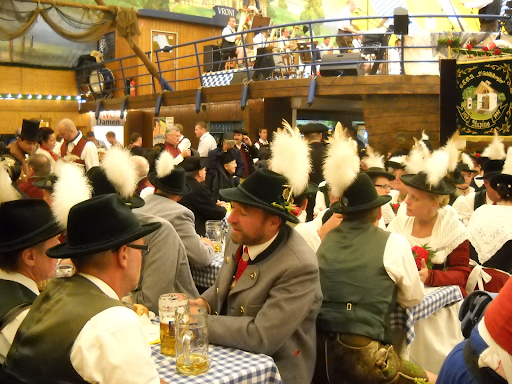Oktoberfest is coming up, and that means lederhosen and drinking, right? Not necessarily! There’s way more to it than just that.
Thanks to social media and the internet, different cultures are able to share and learn about each other easier than ever before! However, it’s important to navigate the fine line between cultural appreciation and cultural appropriation. In this blog, we delve into the concept of cultural appropriation, talk about recent cases, and explain how to avoid making the same mistakes.
Cultural appreciation vs. Cultural appropriation
Cultural appreciation involves embracing, respecting, and honoring diverse cultural practices, while appropriation refers to borrowing elements from marginalized cultures without fully understanding or acknowledging their significance. Cultural appropriation often involves power imbalances, where members of a dominant culture adopt elements from marginalized cultures, thereby perpetuating stereotypes, erasing cultural contributions, and trivializing traditions.
On the other hand, cultural appreciation involves genuinely embracing, respecting, and honoring diverse cultural practices. It entails seeking knowledge, understanding the historical context, and recognizing the significance behind certain cultural elements. Appreciation is about engaging with a culture in a way that fosters mutual understanding, respect, and celebration of its richness and diversity.
Cultural appropriation in pop culture, fashion, and social media is all too common. The problem arises when cultural practices are adopted solely for their aesthetic appeal, without recognizing the historical and social significance they hold for the communities they originated from. For example, the Kardashians sparked controversy for sporting cornrows without acknowledging their cultural roots.
Addressing the situation is just as crucial if one gets caught up in a cultural appropriation scandal. One recipe creator on Tiktok, “Half Baked Harvest,” claimed to recreate a well-known Vietnamese dish, but used flavors from other Asian cultures such as Japanese and Thai. In response to the backlash, she ignored the problem completely – and continued to make content.
Responses to incidents of cultural appropriation matter; had the creator apologized and corrected the issue, their audience would likely have felt that a creator they enjoyed cared about not only their feedback, but about appropriately and respectfully representing a culture as well.
Example 1: NFL Hispanic Heritage Month
During a recent NFL Hispanic Heritage Month campaign, a significant backlash erupted due to the campaign’s insensitive messaging and lack of cultural understanding. The National Football League added a tilde over the “N” in their NFL shield logo. The NFL claimed to honor Hispanic Heritage Month by “integrat[ing] unmistakable Latin flavor,” which could be considered cultural appreciation on its own. However, in the Spanish language, the “eñe” is its own letter, and the NFL claimed that the “electric brush stroke of the ‘eñe’ is filled with an infectious personality that is carried out through the rest of the look [and] feel.”
Despite all the backlash and criticism across social media platforms, the NFL did not respond to the situation.
Example 2: Great British Bake Off – Mexican Week
The Great British Bake Off is a UK baking competition for amateur home bakers to compete for a top prize and has been around since 2010. In their most recent season, the series came under fire for “Mexican Week” where they perpetuated stereotypes of tequila and tacos to represent the culture as a whole. The episode opened with the show’s hosts sporting sombreros, ponchos, and holding maracas throughout the episode.
What makes matters worse is that this isn’t the first time the show was scrutinized for cultural appropriation. In a previous season, they hosted a “Japanese Week” that focused on anime and “kawaii” cakes to represent Japanese culture.
Following the controversy of “Mexican Week,” Prue Leith, one of the show’s judges, said in an interview with The New Yorker, “There would have been absolutely no intention to offend. That’s not the spirit of the show.”
Example 3: Disney’s “Harmony in Color” Parade
In March 2022, during a Walt Disney World Magic Kingdom parade, a Texas’ Port Neches-Grove High School drill team called “The Indianettes” had a particularly jarring performance. The routine featured racially offensive Native American stereotypes such as chants, costumes, and poses. What made matters even worse was the chant.
The team did stereotypical “war whoops” and chanted, “I-N-D-I-A-N-S, scalp ‘em, Indians, scalp ‘em!” This performance quickly went viral, and people pointed out that the team costume normally includes ceremonial headdresses, which are traditionally worn by tribe leaders. This is considered highly disrespectful, as the right to wear one must be earned within a tribe.
In response to the backlash, Disney spokesperson Jacquee Wahler stated that “[the performance] was not consistent with the audition tape the school provided, and [they] immediately put measures in place so [the incident] is not repeated.” As expected of a large corporation such as Disney, they did well to address the situation. They put preventative measures in place to avoid a repeat, rather than just apologizing and moving on. However, it should be noted that this team had previously performed the same dance and chant at Disney in 2020.
Avoiding cultural appropriation
As a brand, it’s important to avoid cultural appropriation or perpetuating stereotypes. Not only is this a bad look for your brand, but it’s not doing marginalized communities any favors. This can be achieved by doing a little research and taking the time to get to know the culture you’re trying to appreciate. Here are some tips for how you can avoid appropriating other cultures when making content or putting together marketing materials.
- Do your research – research can lead to a deeper understanding of the cultural significance behind practices and symbols. Without proper research, there is a risk of misrepresenting or trivializing a culture, leading to harmful stereotypes.
- Keep in mind your position – consider the privilege you may hold to keep in mind the power imbalances and historical context behind cultural elements. By acknowledging your privilege, you can approach cultural exchange with humility and empathy, and show a willingness to learn and respect diverse traditions.
- Acknowledge marginalized communities – when celebrating another culture, it’s equally crucial to source components from the celebrated community. This approach fosters a more equitable and respectful cultural exchange while avoiding the pitfalls of misrepresentation.
- Give credit where credit is due – similar to doing your research, when making content, you can take it as an opportunity to educate. Proper credit ensures that the contributions and traditions of marginalized communities are recognized and respected.
Taking responsibility
After any sort of scandal, it is always important to address the issue and take responsibility. When individuals or organizations promptly take ownership of their actions, it shows a willingness to learn and grow. Failing to handle a situation is like disregarding the issue, contributing to ignorance. By recognizing the consequences of cultural appropriation, we can work towards creating a more inclusive and respectful society. Committing to systematic changes and continuous improvement helps to promote genuine cultural exchange.
Oktoberfest is more than beer
Take Oktoberfest, for example. Yes, it’s a great occasion for drinking beer and wearing lederhosen, but there’s so much more to it than that. It’s actually a really important part of Bavarian culture, and celebrates the marriage of King Ludwig way back in 1810, making it one of the oldest festivals in the world.

During the 16-day festival, over two million gallons of beer are served, but it’s not all about the beer: half a million chickens, 300,000 sausages, and nearly 100,000 pork shanks are served. There are 14 large tents, 20 small tents, and each has its own band playing live folk music. If you didn’t take a little time to research its origins, you’d think it’s just an excuse to drink rather than appreciate Bavarian culture, its music, and its food.
Moving forward
It is essential to recognize that cultural exchange goes beyond surface-level representation and the fine line that separates cultural appreciation and cultural appropriation. Often fueled by ignorance and power imbalances, cultural appropriation can perpetuate harmful stereotypes and trivialize traditions. Understanding the significance of cultural elements and engaging in mutual respect and celebration creates a more inclusive and enriching exchange. As such, it is always important to stay cognizant of one’s actions, and having a second opinion doesn’t hurt. Contact us today!




